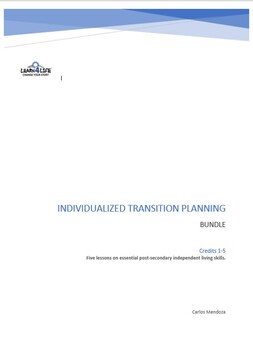Individualized Transition Planning (ITP) - Independent Living Skills Credits 1-5
- Zip
Products in this Bundle (5)
Description
This course is designed in an effort to prepare students with Individualized Education Plans (IEP) for post-secondary independent living. The purpose of transition planning is to help prepare students to be independent young adults. This course will introduce and discuss essential independent living skills necessary for students to be successful as they transition into post-secondary living. Transition planning is a formal process within the IEP. It is required by the Individuals with Disabilities Education Act (IDEA).
The following lessons are included in this bundle:
1. Time Management:
Students will comprehend and apply vocabulary as it relates to time management. Students will identify daily, weekly, or monthly tasks and learn that each task consists of multiple objectives in order to complete the task in its entirety. Students will learn the importance of prioritizing tasks and responsibilities.
2. Financial Preparedness:
Students will learn how to save money for things they want or need. Students will understand that everything has a cost or trade-off. Students will learn to create a budget and approximate their income. Students will learn how loans can be useful and how they relate to debt. Students will comprehend the importance of saving. Students will comprehend the basics of credit.
3. Caring For Your Health:
Students will learn to distinguish different types of medical care. Students will rate health concerns according to their urgency. Students will learn how to read a prescription drug label. Students will associate over-the-counter medications with health concerns. Students will learn how to respond to emergency situations.
4. Community Resources:
Students will become knowledgeable about resources within their community. Students will learn the difference between public places and places that are not always open to the public. Students will learn how to utilize an online contact resource. Students will learn about specific companies that are available to provide specific services.
5. Cyber Addiction & Cyber Bullying:
Students will understand the differences and similarities between cyber addiction, cyber bullying, and bullying. Students will gain knowledge related to the warning signs of cyber addiction, cyber bullying, and bullying. Students will learn methods of identifying positive & negative behaviors as they relate to cyber addiction. Students will distinguish between safe and unsafe situations as they relate to cyber addiction and cyber bullying.


